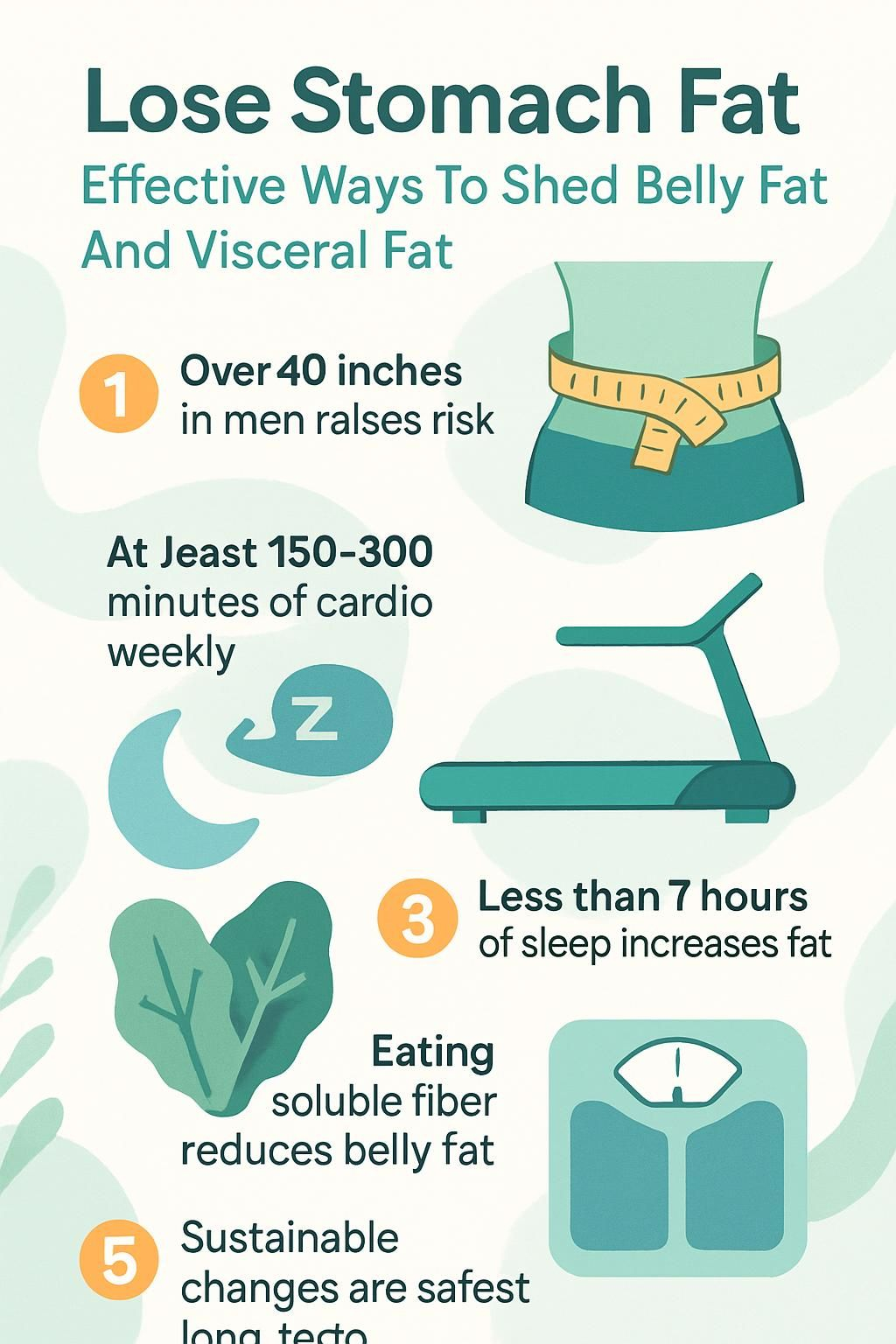Lose Stomach Fat: Effective Ways To Shed Belly Fat And Visceral Fat
Our Nutrition Assistant AI Suite will transform your body. You will lose fat, get toned, and build muscle. Gain confidence and optimal health.
If you find it hard to lose belly fat, you are not alone. Extra fat around your waist, especially visceral fat deep inside your abdomen, raises the risk of heart disease and diabetes. You can lower that risk with clear steps that fit real life.
This guide shows simple, proven ways to shed belly fat using smart nutrition, exercise, and daily habits. The advice is evidence-based and easy to follow. Use it as a roadmap to a healthier waist and better energy.
Key Takeaways
- Waist sizes above 40 inches in men or 35 inches in women point to higher disease risk and higher death rates, according to the Mayo Clinic.
- More soluble fiber, lean protein, and healthy fats like olive oil and nuts, plus fewer added sugars, support a drop in abdominal and visceral fat.
- Aerobic exercise for 150 to 300 minutes per week, strength training twice weekly, and short HIIT sessions target stubborn belly fat more effectively.
- Chronic stress and fewer than seven hours of sleep raise cortisol, a stress hormone that promotes visceral fat gain, based on studies from 2006 and 2023.
- Sustainable lifestyle changes, not crash diets, are the safest way to keep stomach fat off, as shown in research from Johns Hopkins Medicine and Mayo Clinic.

Understanding Belly Fat and Visceral Fat

If you want to lose belly fat and protect your health, it helps to know how your body stores fat. Abdominal fat includes both pinchable fat under the skin and hidden fat around your organs. Each type behaves differently and affects risk in different ways.
What is belly fat?
Belly fat is extra fat stored around your abdomen. It includes subcutaneous fat, which sits under your skin, and visceral fat, which surrounds your internal organs. Both raise risk, but visceral fat is more dangerous.
For women, a waist above 35 inches, or 89 centimeters, signals a higher risk for heart disease and type 2 diabetes. Belly fat often grows with high-calorie diets, little movement, or hormone shifts such as menopause. It can raise your total body fat percentage and strain your heart and metabolism.
A simple tape measure helps you track progress. Measure at the level of your belly button, snug but not tight, and keep the tape level around your body.
What is visceral fat and why is it risky?
Visceral fat hides deep in your abdomen around your liver, kidneys, and intestines. Unlike the fat you can pinch, this hidden fat is linked to chronic disease because it sits near vital organs.
Too much visceral fat drives inflammation and insulin resistance. That raises the odds of type 2 diabetes, high blood pressure, abnormal blood fats, fatty liver disease, sleep apnea, stroke, and certain cancers. Studies connect excess intra-abdominal fat with higher mortality.
Body mass index, or BMI, does not show visceral fat or body composition. A man with a waist over 40 inches, or a woman over 35 inches, can have dangerous hidden fat even if BMI looks normal.
Visceral adiposity appears to be associated with increased risk for cardiovascular diseases independent of total obesity. (Mayo Clinic)
Visceral fat may not show on a scale, but it affects hormones like insulin and cortisol, the stress hormone. That shift harms metabolic health and can speed up disease risk.
How do subcutaneous fat and visceral fat differ?
Subcutaneous fat sits just under your skin. You can pinch it on your arms, thighs, or belly. Clinicians sometimes measure it with calipers to track change over time.
Visceral fat lives deeper, wrapped around your organs. You cannot grab it, and it raises the risk of heart disease and diabetes. Waist circumference is a simple estimate. Wrap a tape just above your hipbones, keep it level, and measure after you exhale.
Subcutaneous fat tends to be less harmful than visceral fat. That is why shrinking your waist, not only your scale weight, matters for long-term health.
Nutritional Strategies to Target Belly and Visceral Fat
Food choices shape how your body stores fat. A balanced plate helps you lose belly fat while protecting muscle and metabolism.
Which fiber-rich foods help reduce belly fat?
Soluble fiber slows digestion and helps you feel full longer. In one long study, every 10-gram increase in daily soluble fiber was linked to 3.7 percent less belly fat gain over five years.
- Oats are rich in soluble fiber and make a steady breakfast that can curb hunger.
- Barley provides dense fiber, which supports lower visceral fat mass.
- Legumes like lentils, black beans, peas, and chickpeas pack fiber and protein.
- Fruits such as apples, oranges, pears, and berries supply pectin and antioxidants.
- Vegetables like broccoli, carrots, Brussels sprouts, and artichokes boost fullness.
- Whole grains including brown rice and quinoa slow digestion and steady energy.
- These foods support gut health and help you reach or maintain a healthy weight.
How do lean proteins aid fullness and muscle growth?
Lean proteins help control appetite between meals and protect muscle. Eggs, chicken, fish, dairy, beans, and tofu deliver amino acids, the building blocks your body uses to repair tissue.
More protein can raise metabolism because muscle burns more calories at rest than fat. Research suggests higher-protein diets help reduce belly fat while preserving skeletal muscle. A 2012 study found people lost less lean mass during calorie cuts when they ate more protein.
Include a source of lean protein at each meal. That habit supports stronger abdominal muscles and better results from both aerobic exercise and strength training. For details, see the systematic review: https://www.ncbi.nlm.nih.gov/pmc/articles/PMC4899993/
Why should I cut back on sugary and processed foods?
Processed foods often contain trans fat, added sugar, and excess sodium. These raise calorie intake and stall fat loss. Fructose-heavy drinks and convenience foods increase abdominal fat and raise the risk of type 2 diabetes.
People who eat the most ultra-processed foods tend to carry more visceral fat. Many low-fat items hide sugar to boost taste. Read labels and choose foods with fiber, protein, and simple ingredients.
Reducing refined carbs helps shrink your waist. Moderation works better than strict bans, and small swaps build confidence over time.
What are the benefits of healthy fats like olive oil and nuts?
Healthy fats include monounsaturated and polyunsaturated fats found in olive oil, nuts, and avocados. These fats enhance fullness and can replace saturated fat from butter or high-fat dairy.
Swapping saturated fat for vegetable oil supports blood vessel function and lowers the risk of type 2 diabetes. Mediterranean-style eating that favors plants and unsaturated fats helps reduce body fat, including belly fat. Meta-analysis summary: diets higher in unsaturated fats and plants show better visceral fat loss than low-fat diets.
How does moderating alcohol intake affect belly fat?
Alcohol adds easy calories that collect around the waist. A 2023 analysis linked drinking with greater visceral fat. Earlier research found that people who drink less than one drink per day have less abdominal fat than binge drinkers.
Follow the Dietary Guidelines, up to two drinks daily for men and one for women. Cutting back trims calories and supports a healthier liver and heart. Many people notice a smaller waist and better energy within weeks.
Why is staying hydrated important for fat loss?
Hydration helps metabolism and appetite control. Replacing sugary drinks with water reduces calories and added sugar. Swapping one daily soda for water can remove tens of thousands of calories over a year.
Water supports exercise performance and recovery. That means you can train a bit harder and burn more calories. Carry a refillable bottle, choose unsweetened drinks, and sip before meals to help manage hunger.
Exercise Plans for Reducing Belly Fat
Exercise burns calories, protects muscle, and teaches your body to use fat for fuel. Combine cardio, resistance work, and brief intervals for the best results.
What cardiovascular exercises burn belly fat effectively?
Cardio helps cut belly fat and visceral fat and supports a healthy weight. Pick activities you enjoy so you stick with them.
- Running burns calories quickly, especially at moderate to vigorous intensity.
- Swimming works your whole body and keeps your heart rate up.
- Cycling improves stamina and targets large muscle groups around the hips.
- Dancing raises your heart rate and makes training more fun.
- Brisk walking is low impact and effective at 150 minutes per week or more.
- Rowing trains your back, arms, and core for high calorie burn.
- Jump rope offers intense cardio in a small space.
- Group classes like Zumba add social support and structure.
- Training five days a week helped one client trim two inches from the waist in three months.
In a 2015 study, postmenopausal women who did 300 minutes of cardio weekly lost more visceral fat than those who did half as much. Combine cardio with strength work for the strongest effect.
How does strength training help reduce belly fat?
Strength training builds and preserves lean muscle mass. More muscle means a higher resting calorie burn, which helps reduce total body fat, including belly fat.
Experts suggest at least two sessions per week. A 2014 study showed that teens who combined resistance training with cardio saw the biggest drops in visceral fat. If you have prediabetes, type 2 diabetes, or fatty liver disease, resistance work can lower both subcutaneous and visceral fat.
Pair your lifting routine with a lower-carbohydrate eating plan if it fits your health needs. This approach can speed fat loss while protecting lean tissue.
What is high-intensity interval training (HIIT) and how does it help?
HIIT mixes short bursts of hard effort with brief recovery. For example, sprint for 30 seconds, then walk for one minute, and repeat. Sessions often last 15 to 25 minutes.
Research shows HIIT can reduce stomach and visceral fat faster than steady cardio. Combining HIIT with resistance training helps people lose weight while keeping muscle. Intense intervals raise your calorie burn during the workout and after it ends as your body recovers.
Try HIIT two or three times per week along with steady activities like walking or biking. Keep sessions short and technique sharp to lower injury risk.
Why is daily physical activity important for fat loss?
Daily movement helps your body use fat for fuel and manage insulin, the hormone that controls blood sugar. Lower insulin during activity reduces fat storage and supports a healthier liver.
Aim for 30 to 60 minutes of brisk walking, cycling, or swimming most days. Track steps or plan an evening walk after dinner. Consistency matters more than perfection.
Lifestyle Changes for Sustaining Fat Loss
Small daily habits shape your waistline. Simple routines make it easier to keep weight off over time.
How can managing stress lower belly fat?
High stress raises cortisol, which increases appetite and directs fat storage to your waist. Women with larger waists often show higher cortisol levels and gain more abdominal fat.
Use yoga, breath work, prayer, or short meditations to ease tension. These practices reduce emotional eating and support steadier choices. Calmer days often bring steadier meals and fewer cravings.
Why is getting enough sleep crucial for fat loss?
Short sleep is linked to weight gain and more belly fat. In a large 2006 study, women who slept less than five hours per night gained more weight than those who slept at least seven hours.
Too little sleep raises cortisol and weakens hunger control. Sleep apnea also links to higher visceral fat. Aim for seven to nine hours of quality sleep. Build a bedtime routine, dim screens, and keep the room cool and dark.
How should I track my progress consistently?
Progress does not always show on the scale. Muscle gain can offset fat loss. That is why you should track more than weight.
Use a food log or app to monitor calories and macronutrients. Track workouts and weekly activity. Measure waist circumference just above the hipbones with the tape level and snug after a relaxed exhale.
Also note how your clothes fit and how you feel during activity. A multi-metric view keeps you motivated and helps you spot plateaus early.
Why choose sustainable dietary changes over crash diets?
Sustainable changes help you lose belly fat slowly and keep it off. Crash diets often lead to quick regain, lower muscle mass, and slower metabolism.
Focus on fiber, lean protein, healthy fats, and hydration instead of strict rules. This steady style reduces the return of visceral fat and supports long-term health. If you struggle with disordered eating, reach out to a healthcare professional or call the National Alliance for Eating Disorders helpline. The Substance Abuse and Mental Health Services Administration offers 24-7 support at 1-800-662-4357 (TTY: 1-800-487-4889).
Foods and Beverages That Promote Fat Burning
Certain foods can support fat use at the cellular level. These choices will not melt fat by themselves, but they can tilt the odds in your favor.
How do probiotics like yogurt aid fat loss?
Probiotics are helpful bacteria found in yogurt, kefir, sauerkraut, and kimchi. Some strains, such as Lactobacillus, may reduce belly fat by improving how your gut processes nutrients and inflammation.
Studies show that eating probiotic-rich yogurt for 12 weeks can reduce belly fat in some people. If you plan to use supplements or make major changes, talk with your healthcare provider first.
What are the fat-burning benefits of green tea?
Green tea provides caffeine and EGCG, a plant compound that supports fat burning, especially during exercise. Research suggests that drinking green tea daily for about twelve weeks can lower weight and waist size when combined with healthy habits.
Several studies report modest benefits for belly fat reduction. Keep total intake under 500 milligrams of EGCG per day unless your clinician advises otherwise.
Which omega-3 sources support belly fat reduction?
Omega-3 fats help lower inflammation and may reduce visceral fat. You can get them from seafood, plants, or algae-based supplements.
- Fatty fish like salmon, mackerel, sardines, herring, and anchovies. Aim for two to three servings weekly.
- Algae-based omega-3 supplements if you do not eat fish.
- Walnuts, flaxseeds, and chia seeds for a plant form called ALA.
- Studies suggest omega-3s support liver health and protect against disease as part of a balanced diet.
- Some research shows DHA supplements can lower liver fat in children at risk for fatty liver disease.
- Pair fatty fish with whole grains or leafy salads to support fullness and calorie control.
- Many people feel more satisfied when meals include a small omega-3 source.
Use these foods regularly, not just during short diet phases. Consistency helps your results stick.
Avoiding Common Weight Loss Errors
Mistakes can stall progress. Avoid these common traps so your effort pays off.
Why should I avoid quick fixes and fad diets?
Rapid belly fat loss claims are misleading. Your body cannot safely drop significant visceral fat in one week. Severe diets cause dehydration, muscle loss, and a slower metabolism, not true fat loss.
Extreme plans can also trigger disordered eating. If you notice risky patterns, contact a healthcare professional or the National Alliance for Eating Disorders helpline. For 24-7 support, call 1-800-662-4357 (TTY: 1-800-487-4889).
How does sleep affect weight management?
Short sleep raises your risk of weight gain, especially around the waist. A 16-year study of 68,000 women found that sleeping under five hours per night linked to more weight gain than sleeping seven or more hours.
Poor sleep harms hunger signals and pushes cravings for sugary foods. Sleep disorders like sleep apnea are tied to higher visceral fat. Seek medical care if sleep problems persist.
Why limit sugary drinks and fruit juices when losing fat?
Sweet drinks like soda, punch, sweet tea, and sugary mixers pack fructose. Liquid calories do not fill you up, so you may eat more later. That pattern drives belly fat gain.
Even 8 ounces of unsweetened apple juice has about 24 grams of sugar. Choose water, unsweetened tea, or sparkling water with citrus. These swaps cut calories and support a smaller waist.
Genetic and Hormonal Influences on Fat Storage
Your genes and hormones shape how and where your body stores fat. You can still change the outcome with daily habits.
How do genetics affect where I store fat?
Genes influence your risk for obesity and where fat settles, including your belly. If close relatives carry weight around the waist, you may have a similar pattern. Lifestyle still matters, and smart choices can blunt genetic risk.
Hormone shifts tied to age and genes can change how much subcutaneous or visceral fat you gain. Knowing your family pattern can help you plan steps sooner.
What hormonal factors influence fat storage, like insulin and cortisol?
Insulin moves glucose from your blood into cells. Diets high in sugar and refined carbs keep insulin high, which signals your body to store more fat in the abdomen. Cortisol rises with stress and also shifts fat to your waist.
Many women notice more belly fat after menopause because lower estrogen changes fat distribution. Regular exercise and steady meals can lower insulin and cortisol. That helps your liver burn fatty acids from visceral stores rather than saving them as extra pounds.
Advantages of Shedding Belly and Visceral Fat
Trimming your waist supports your heart, metabolism, and daily energy. Even small losses create meaningful health gains.
How does losing belly fat reduce risks of heart disease and diabetes?
Visceral fat surrounds organs and disrupts blood pressure, cholesterol, and blood sugar. Reducing your waist below 35 inches for women and 40 inches for men lowers risk for heart disease and type 2 diabetes.
Research from Johns Hopkins shows that weight loss from diet plus exercise improves cardiovascular risk factors. Healthier waistlines usually bring better blood sugar control and improved cholesterol patterns.
In what ways does fat loss boost metabolism and energy?
Strength training raises lean muscle mass, which burns more calories at rest than fat. As visceral fat drops, blood vessels work better and deliver more oxygen and nutrients to organs.
Many people sleep better as they lose weight. Better sleep brings clearer focus and steadier energy. Over time, more muscle and less stored fat make daily tasks feel easier.
How can reducing belly fat improve self-esteem and fitness?
As your body composition improves, clothes fit better and confidence grows. That positive feedback can strengthen healthy habits and goal setting.
Regular training builds strength, stamina, and mobility. Support from friends or groups adds motivation and makes the journey more enjoyable.
Conclusion
Targeted nutrition, steady exercise, quality sleep, and stress control help you lose belly fat and lower visceral fat. These habits reduce the risk of heart disease, diabetes, and other chronic problems while boosting energy and mood.
Focus on whole foods with fiber and protein, train most days, and track your waist with a tape measure. Progress shows up in how your clothes fit and how you feel, not just on the scale. For medical conditions or major diet changes, consult a qualified healthcare professional.
Sources for credibility: Johns Hopkins Medicine on low-carbohydrate weight loss and Mayo Clinic guidance on belly fat in men and women.
FAQs
1. What are the most effective ways to lose stomach fat and visceral fat?
Research shows that a balanced diet, regular exercise, and enough sleep help reduce belly fat and visceral fat. Aerobic activities like brisk walking or cycling burn calories efficiently. Strength training builds muscle mass which increases metabolism. Studies from the National Institutes of Health confirm these methods work best when combined.
2. How does diet affect belly fat loss?
Eating fewer processed foods lowers calorie intake and helps control weight gain around the waistline. Diets high in fiber, lean protein, fruits, and vegetables support healthy digestion while reducing hunger cravings. A table published by Harvard Medical School lists whole grains as more effective than refined grains for losing abdominal fat.
3. Can stress impact efforts to shed stomach fat?
Chronic stress raises cortisol levels which can increase storage of visceral fat in the abdomen area according to research from Mayo Clinic. Practicing relaxation techniques such as deep breathing or meditation may lower stress hormones and improve results over time.
4. Is there a difference between subcutaneous and visceral abdominal fats?
Subcutaneous adipose tissue sits just under your skin while visceral adipose tissue surrounds organs inside your abdomen cavity; both types respond differently to lifestyle changes based on studies cited by Johns Hopkins University School of Medicine.
Summary: Losing excess abdominal weight requires consistent effort through nutrition choices, physical activity routines, good sleep habits, and managing daily stressors; evidence supports combining these strategies for lasting results.







